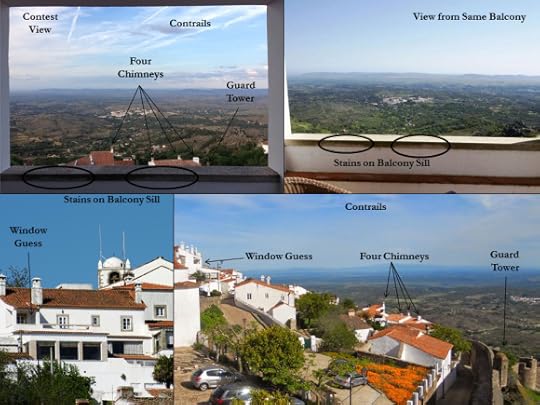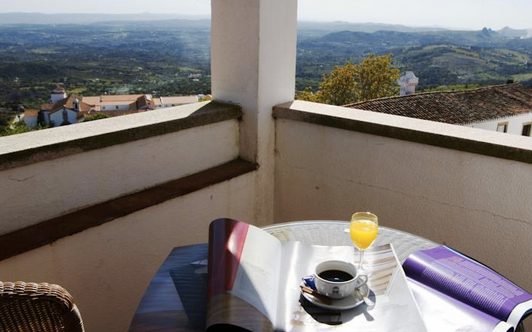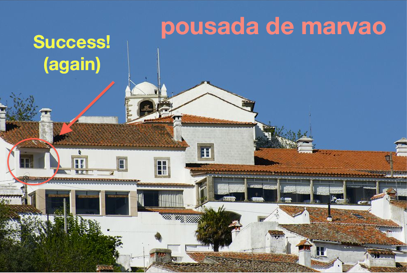Andrew Sullivan's Blog, page 92
November 18, 2014
Tumblr Of The Day
Bad Kids Jokes, also on Twitter:
what is white and black and can fly??!
a fridge with black paint on it falling from a tree
— bad kids jokes (@badkidsjokes) November 3, 2013
what did the toloit roll say to toilot? i keep getting ripped off and wiped on big bums
— bad kids jokes (@badkidsjokes) November 11, 2013
man:waiter how long will my pizza be ? waiter:not very long. lol
— bad kids jokes (@badkidsjokes) November 4, 2013
Dylan Matthews recommends it:
Bad Kids Jokes is a Tumblr that offers exactly what the name promises. “I moderate jokes on a Kids Jokes website,” the person behind it writes, as though “kids jokes websites” are a recognizable genre of website. “A lot of joke submissions can’t be published because they don’t make any sense, the child got a genuine joke completely wrong, or they’re a bit too rude for kids … so I publish them here instead.” The result is 33 pages of child-penned Dadaist nonsense, much of it concerning bodily discharges and/or the perfidy of teachers, and all of it hysterical.









Chewing Over Executive Action On Immigration, Ctd
I’ve been struggling with the issue of precedents for Obama’s proposed deferral of deportation initiative, so it behooves me to link to Mark Krikorian’s argument that the Reagan and Bush deferrals should not be counted as apposite. His first point is numerical:
Despite claims at the time that “as many as 1.5 million” illegal aliens might benefit from the policy, the actual number was much, much smaller. In 1990, Congress passed legislation granting green cards to “legalization dependents” — in effect codifying the executive action Bush had taken a just few months earlier. That (lawful) measure actually cast the net wider than Bush’s action, and yet only about 140,000 people took advantage of it — less than one-tenth the number advocates claim.
But could it be that the purported beneficiaries of the current deferral are also being over-estimated? What matters, surely, is how many children Reagan and Bush thought would be protected by their executive actions, if we are looking for a precise precedent of presidential intent. And the Reagan/Bush precedent did give the deferred the right to work. There’s also the argument that as a percentage of the total population of illegal immigrants, the numbers are not so dissimilar. In 1990, there were an estimated 3.5 million illegal immigrants in the US – so deferring deportation for 1.5 million meant deferring it for 43 percent of the relevant population. In 2014, there are 11.7 million illegal immigrants, of which up to 4 million would be affected by the proposed deferral. That’s 34 percent or 42 percent if you include the DREAMERs. Seems like a rough precedent to me.
Then Kirkorian argues that the Reagan/Bush precedent was a mere tidying up after the 1986 amnesty – and not a unilateral attempt to bypass the Congress:
It was a coda, a tying up of loose ends, for something that Congress had actually enacted, and thus arguably a legitimate part of executing the law — which is, after all, the function of the executive. Obama’s threatened move, on the other hand, is directly contrary to Congress’s decision not to pass an amnesty. In effect, Bush was saying “Congress has acted and I’m doing my best to implement its directives,” while Obama is saying “Congress has not done my bidding, so I’m going to implement my own directives.”
But a tidying up can mean many things. In this case, it meant giving a reprieve from deportation that the law did not itself contain. Yes, it was subsequently superseded by the 1990 law – but that indicates to me that it needed a law to make it more than an executive decision. And yet that executive action nonetheless went ahead.
It seems pretty clear to me that Obama may not be as out on a limb as some Republicans are claiming – but that he is pushing his luck in ways that, as I’ve argued before, are likely to hurt him and even the cause he seeks. He could make immigration a political liability for Democrats rather than for Republicans; or at the very least be credibly described as an initiator of partisan conflict, with unforeseen consequences. If I were advising POTUS, I’d urge that he use this threat as a way to negotiate an expeditious immigration reform bill. If that fails, by all means blame the Republicans. But it would be an act of great recklessness – both for his future and his legacy – to press ahead regardless.









The View From Your Window
Some Suggestions On Gender Wars
Here’s a modest proposal that might help us bridge some differences: an avoidance of arguments in the gender debate that there is no legitimate debate to be had. There is always a debate to be had in any area of human inquiry or life – because most social and political questions weigh one good against another. So, to take an obvious example, the fight over “affirmative consent” balances the security of women from assault and rape against the due process rights of the accused. These things conflict in a liberal polity – because in a liberal world, moral, collective imperatives cannot properly come at the expense of individual injustice.
And it is simply a fact that there are cases of false allegations of rape, just as there are false accusations of every sort of crime. They’re very small in number, and we may exaggerate the problem, but they do exist. My instinct, for what it’s worth, in almost all these cases is to believe the woman. That goes for most alleged crimes and offenses regarding gender, including harassment in the workplace. Readers may have gotten the wrong impression from me about this, but from Anita Hill to Paula Jones, I’ve long supported the women’s side in some of these high profile cases. But there is always another side, and that requires some consideration. Even Bill Clinton deserved that. And what troubles me is the assertion by some on the fem-left side that there is only one side ever. And that even questioning that assertion is a sign of moral failure.
Take this piece from the Guardian today, lambasting Jed Rubenfeld’s nuanced take on the question in Sunday’s NYT. And notice not the engagement with another point of view, but a blanket dismissal of its right even to exist:
You might think that someone given a platform at the New York Times, like Yale law professor Jed Rubenfeld was in Sunday’s paper, might have done more than simply note that women are attacked “in appalling numbers” and colleges mishandle rape cases … The worst offense is Rubenfeld’s apparent belief that there is a “debate” to be had – as if there are two equal sides, both with reasonable and legitimate points. There are not. On the one side, there are the 20% of college women who can expect to be victimized by rapists and would-be rapists; on the other side is a bunch of adult men (and a few women) worrying themselves to death that a few college-aged men might have to find a new college to attend.
That echoes Ezra Klein’s endorsement of expelling male students accused of rape without due process. The contention is that it is neither legitimate nor reasonable to worry about someone being punished for a terrible crime he did not commit. And if this is something that worries you, then you really need to be educated by those more informed on the issue before you open your mouth:
If you can’t talk about rape without blaming victims, don’t talk about rape.
If you do happen to express concern about individuals losing due process in defending themselves from a charge that will follow them their entire life, you are one of the following: a male (ugh); a rapist-excuser; a rapist-enabler; or a “regressive rape apologist.” Or even worse, you are a “rape-truther” even if you cite three actual cases of alleged false accusations. The TPM piece that used that term did not prove that those cases didn’t exist, it merely insisted that they cannot exist. Remember “trutherism” was coined to describe delusional maniacs who believed the US government was behind the 9/11 attacks, despite massive, voluminous, unimpeachable evidence that this was not the case. But a college rape case we don’t even know the details of? This is a way not of engaging in debate, but of shutting it down.
Over the years, I’ve learned the various tricks to prevent free and open discussion: you’re not educated enough to talk about it; you’re male/female/black/white/gay/straight/Jewish/gentile or whatever and that disqualifies you from an opinion; you’re irresponsible even to raise the issue. But the over-arching theme is simply describing an argument as a moral delinquency rather than an intellectual mistake. If that is the nature of our public discourse, we are no longer in a discourse at all. We are in a church.









Will Obama’s Executive Amnesty Prove Popular?
Americans are split on whether Obama should take action:
The split is somewhat counterintuitive, since a strong majority of Americans approve of what is likely to be the key element of the executive action: effectively legalizing millions of immigrants who are here illegally. As Post pollsters Peyton M. Craighill and Scott Clement pointed out over the weekend, 57 percent of those who voted on Nov. 4 favored legalization for these people, while 39 percent wanted deportation, according to exit polls. And even that split was actually narrower than most polls have shown.
But in politics, the process matters too, and many of those who otherwise support legalization also appear opposed to or hesitant about doing so without the regular checks and balances of the legislative and executive branches.
Yglesias bets that the executive action will help Democrats:
Hill staffers who believe in the political power of immigration reform point out that one of the biggest substantive drawbacks of executive action — its very tenuousness — is a political asset. What discretionary authority giveth, discretionary authority may taketh away, after all. If a Republican wins the White House in 2016, there will be no checks and balances to stop him from ordering the deportation of millions of immigrants granted relief by Obama. This dramatically heightens the stakes, not just for the immigrants themselves (who of course won’t be eligible to vote) but for their friends, family, coworkers, and employers.
Of course the higher stakes also involve higher stakes of backlash. But from the viewpoint of the party that benefits from higher turnout, the risk-reward ratio looks good.
Josh Marshall is on the same page:
If there are 5 million people who are affected by this order, the number of people who either have family ties to these individuals or affective relationships with them is much larger. I don’t know if it’s 15 million or 20 million or 40 million. But it’s a lot more than 5 million people who will feel acutely the fate of these people hanging in the balance with the 2016 election. And advocates on both sides of the immigration divide, deporters and pro-immigrant activists will press the issue throughout the 2016 cycle. The 5 million affected can’t vote and won’t be able to for years. But many family members, friends, community members and employers can.
Jennifer Rubin, on the other hand, argues that “it is essential that every Democratic senator and congressman in the new Senate take a vote (be it on the merits or on cloture of a filibuster) on the issue of executive action”:
At some point, they will need to face the voters and explain why they abdicated their responsibility and power to the executive branch. Maybe this is why Sen. Claire McCaskill (D-Mo.) declared about executive action on immigration, “I am not crazy about it,” although she blamed the GOP-controlled House for not acting on the issue. For someone who understood the voters’ intentions well enough to vote against Sen. Harry Reid (D-Nev.) as the new minority leader, surely she could see that the voters dislike unilateral action as much as they dislike the Reid era in the Senate. In any case, make each Democrat vote.
Frum selects another ripe target:
The president’s plan would be costly. The vast majority of those who would gain residency rights under the president’s reported action will be poor. Their low incomes will qualify them for means-tested social programs just as soon as their paperwork is in order. This will not be a small-dollar item. Forty-one percent of the net growth in the Medicaid population between 2011 and 2013 was made up of immigrants and their children. Legalize millions more poor immigrants, and sooner or later, programs from Medicaid to Section 8 housing vouchers to food stamps will grow proportionately. It’s not widely appreciated how much past immigration choices contribute to present-day social spending. In 1979, people living in immigrant households were 28 percent more likely to be poor than the native-born. By 1997, persons in immigrant households were 82 percent more likely to be poor than the native-born. Wittingly or not, U.S. immigration policy has hugely multiplied the number of poor people living in the United States. The president’s plan will put millions of them on the path to qualifying for welfare benefits.
Meanwhile, Bouie dubs Obama’s executive order a defeat for Republicans:
Democrats weren’t going to relent on immigration. Latinos are an important part of the Democratic coalition and key to the party’s effort to change the partisan dynamic in states like North Carolina, Georgia, Texas, and Arizona. And while Latino disappointment wasn’t determinative in this year’s elections, it’s dangerous for Democrats to delay action through 2016, both on the merits—there’s no guarantee of immigration reform in 2017—and on the politics; absent action on immigration, Latinos might just sit out the presidential election, dealing a blow to Democrats in key states like Florida, Colorado, and Nevada. (To that point, it’s no surprise that lawmakers from the latter two have urged Obama to move with executive action on immigration.)









Healthcare.gov Works – Finally
Waldman pays attention to the site’s success:
The news, an old saying goes, doesn’t cover successful airplane landings. But there’s one extremely notable successful landing happening right now, and unless you’ve gone to the inside pages of your newspaper, you might have missed it: open enrollment for the second year of the Affordable Care Act exchanges has begun, and in its first day, the federal exchange signed up 100,000 customers with only minor technical glitches.
But McArdle warns that this “open enrollment period isn’t the biggest test for Obamacare in the next 12 months”:
The biggest test will be what happens on or around April 15th.
That’s the first time all the people who didn’t buy insurance will get hit with the individual mandate penalty, and the ones who thought that it was a nominal $95 fee are in for a nasty shock. April 15th will also be the first time that people who got too much in subsidies are going to be asked to pay back some of that money. I do not have hard figures on this, but my basic experience in personal finance and tax reporting suggests that approximately zero percent of those affected will be expecting the havoc it will wreak on their tax refund. Brace for a wave of taxpayers angrily complaining to congressmen and their local newspapers. The size of this pressure — and how the administration handles it — will tell us a lot about the future of this program. As will Tax Day in 2016, when the penalties get bigger.



The View From Your Window Contest: Winner #231
A frustrated reader lashes out:
Jesus, could you get any more generic? Scrub brush, an outcropping with a wooden cross, telephone poles, white buildings with red-tiled roofs, a medium-sized range of hills in the background!? An image is beginning to crystallize in my mind of the typical winner of this contest. He is fat, bezitted, wears a carpel tunnel brace and cookie-crumb littered shirt. And he HAS NO LIFE!
So basically:

We love our contest players just the way they are. This one has a highdea:
Something tells me that Granada, Spain - right near the Alhambra. It could be intuition, it could just be the haze of a Saturday wake-and-bake.
Another is thinking the West Coast:
Joshua Tree National Park in Joshua Tree, CA. If that is not correct I am confident it is near there. I was at the Park two weeks ago and it certainly looks like it’s taken near the North entrance of the Park. The town in the background is Twentynine Palms.
Spinning the globe, this reader is going to need a nice red sauce:
When I first saw the contest picture, I said, “if this isn’t Italy, I’ll eat my hat.” Shortly thereafter, my dad found a white cross on some rocks just outside Palermo. Since then, I’ve found another similar cross in south Sicily. That, and the architecture, makes us 90% sure we’re in Sicily. The only other option is Tuscany, but the architecture there is softly different, and I doubt you’d return to Tuscany so soon after the Siena VFYW. Problems of terrain and building style — this window is so unique — mean we can’t find where. But I hope we’re close!
A sanguine reader adds, “Thank you for a few moments of Google touring Umbria – Cortona, Assisi, Abruzzi … it’s all good.” Most everyone correctly guessed some part of Europe this week, but this reader takes us to the right country, albeit the wrong town:
That view is from the village of Monsanto, Portugal. Beautiful place. Rocky:
I’m not sure exactly where the view is from, perhaps the Pousada de Monsanto, but I’m not sure if it’s the lobby, or the breakfast/dining room. Or maybe someplace else, another hotel.
Another reader almost made the same mistake but recovered to nail the correct village and hotel:
Today’s entry comes from a window in the Pousada de Marvão hotel in b-e-a-utiful Marvão, Portugal.
I found almost no helpful hints hidden in this photo (even the seemingly helpful cross in the bottom right quadrant was useless). If the winner reveals some obvious, forehead-slap-worthy clue, I’m going to be pretty crushed. Searching things like “red tile roof valley” yields results for places far and wide: Costa Rica, Venezuela, Indonesia, all of Europe.
While trying to figure out if the palm tree in the lower left corner would yield anything interesting, I found my way to the Wikipedia entry for the European Fan Palm (Chamaerops). One of the countries this particular palm grows in is Portgual. A previous contest led me to mistakenly spend an awful lot of time in Portugal looking for red roofs. Was it about to happen again?
I Googled “Portugal Red Roof Village” and there it was – some place called Monsanto. The very first result features a giant boulder that seems to match the type of rocks in the lower right hand corner of our entry:
I fruitlessly spent the next hour surfing the various villages around Monsanto and trying to piece together the right angle for the window. Nothing worked. I started typing an entry saying that if I had to be wrong, Monsanto was the place to do it. It is seriously lovely.
Before hitting send, I took another peek at my Google Image results and it turns out another lead was sitting there right in the third row. I started poking around Marvão and it was mere minutes before I found my way to the Pousada de Marvão and this week’s view. I think this pull quote from Marvão’s Wikipedia entry says it all:
Nobel prize-winning author José Saramago wrote of the village ‘‘From Marvão one can see the entire land… It is understandable that from this place, high up in the keep at Marvão Castle, visitors may respectfully murmur, ‘How great is the world.’’
Both Monsanto and Marvão were worth making a virtual visit to and I’d love to see them in person. I’m grateful to this contest for showing me that they exist.
As always, Dishheads have been there:
Above is a photo I took a few weeks ago. You can imagine my surprise when I saw this month’s View From Your Window entry. It is taken from Marvao, Portugal, with Santo Antonio das Areias in the distance. I am guessing the photographer was staying in the Pousada de Marvao.
Another rhymes his way to the right window:
My very first guess came way too soon,
Eager elation! I shot for the moon.
Sometimes I suffer, in triangulation,
From Premature Extrapolation.
The town? Well that much I knew in a minute,
Which place, was the tough one – I just couldn’t win it.
But noticing patterns of discolored stone,
That match your sill, the Pousada is known!
Balcony view, the sure winning play,
The room is 210. How I know, I won’t say:
Street views in Marvao? Endless rewards!
But this is, for US, all that Google affords:
But sad to say, that player also blundered,
For only this veteran, nailed the room number:
My first inclination was to search Spain given something about the landscape. I have spent a fair amount of time in Spain searching for other windows. Instead I bounced around Mediterranean countries looking for elongated, red roof tiles and eclectic chimneys similar to those in the contest view. The closest I found was the fortified town of Monsanto in Portugal. It had similar roofs, chimneys, as well as large boulders and outcrops. This prompted a search for Medieval fortified towns of Portugal on high promontories (appropriate for the soaring swifts in the contest photograph). A photograph of Marvão caught my eye because it included the distinct chimneys in the contest view. It was then obvious that the dark brown chimney to the right was, instead, a guard tower on town’s fortification walls. All other clues check out.
Once I found the hotel, it became clear that the contest view was from a balcony and not a window. There were no signs of glass or window framing or fixtures. Photographs from a balcony at Pousada de Marvão had much the same view and identical stains on the granite balcony sill as those barely visible in the contest photograph (see illustration). It is a fairly small balcony on the corner of one of the hotel’s cobbled-together appendages and can be seen in photographs of the hotel’s northeastern façade (see illustration). Based on guest reviews of the hotel, the room is probably #312 (said to be a small room with balcony). Room 310 is over the kitchen which is located northwest of the contest balcony with space for #311 between them. Number 311 is a double room with a terrace balcony which is also visible on the building’s façade.
Views from these fortifications are spectacular and the towns charming, but thoughts of their original purpose and use is actually quite sobering. Maybe it is all the ISIS coverage.
Another former winner looks in on Marvão:
You can see the parish of Santo António das Areias below (similar, but zoomed in picture here). And Spain is beyond those faraway hills. The area is within the Serra de São Mamede Natural Park. For the Room number, I’ll guess #12.
Looking at the list of local events on the town’s website, I have some disappointing news to report. We all missed the 31st annual Feast of the Chestnuts on Nov. 8 & 9 (pictures here) and the pig slaughter in the nearby village of Porto da Espada on Nov. 15.
To paraphrase Andy Zaltzman of The Bugle Podcast, this week I felt like a bad French restaurant. “I [almost] ran out of thyme.” But I got there in the end. (And if you haven’t heard The Bugle, you might listen to John Oliver and Andy’s fuckeulogy to Bin Laden available here.) Thanks for the contest.
Chini had a little more trouble than usual, but it’s not because of carpal tunnel:
Discipline, discipline, discipline. It’s everything in this contest. Unfortunately, I started out this week with none and wound up wasting an hour or more of precious free time fruitlessly searching the Iberian plains. Then, later on Saturday, I applied my usual methods and presto! Location found in fifteen minutes. You lose focus in this game for one second …
This week’s win goes to another veteran without a victory:
There is no view quite like that from Suite 210 of the Pousada de Marvao, looking northeast towards the hamlet of Santo Antonio das Areias, And I should know, since I was chamber maid at that establishment for several months while working my way through hospitality school. YES! We can see it below, oh so clearly circled:
And I’ve got a picture of the view! A different picture of the same exact view!
It’s possible that I have it because I am insane and have wasted another day trying to please you! Or perhaps I took it while cleaning. It was such a beautiful day! Oh, and I know I found some bridge in China, and a water tower in Mendocino, the I Street Bridge in Sacramento, some other bridge on the Oregon Coast and many more. I am lucky that way, and have lived a varied and exemplary life. But time to send me the book so that I can retire from such craziness and return to crosswords.
But why retire when all your future submissions can now be prefaced by “A former winner writes”? Speaking of prefaces, this week’s submission doubles as The View From Your Honeymoon:
The photo was taken from the window of room 312 at the Pousada de Marvao in Marvao, Portugal on September 12, 2014. We were there during our honeymoon (on our way from Lisbon to the Douro River valley.) Marvao is a fortified town on top of a mountain near the Spanish border. Our room had a lovely balcony, from which this picture was taken and on which we ate dinner, drank wine, and looked out at the valley below while it got dark and the lights came on.
I would say the photo would be a hard one with the lack of any real distinguishing features, although I might be surprised as Marvao was named both a UNESCO Heritage Site candidate and was in the book 1000 Places to See Before You Die so people might recognize it from visiting. The town is beautiful, and everyone there was friendly (and quite willing to deal with my extremely poor Portuguese.) Coming from a large city, the quiet from the lack of traffic and general noise was incredibly restful. I highly recommend visiting if you happen to be in Portugal (or western Spain – it’s right on the border); tour the castle, walk the parapet of the medieval walls, and watch the sun set from one of the high points in town.
I do have one caveat – I wouldn’t recommend it for those with a fear of height. The drive up is winding, with some very steep cliffs very close to the edge of the road and a marked lack of guardrails. Drive slow and drive careful, and when you arrive at the top of the mountain, have some port to relax. (Also, on your way down, if you’re headed northwards, Google’s directions are not your friend – it sent us down what I would charitably describe as a horse trail. Lots of fun in a rental car!)
Lastly, the View From Your Heat Map (zoom in by double-clicking an area of interest, or drag your cursor up and down the slide):
We’ll do an easier one next week. See you all on Saturday!



November 17, 2014
Your Monday Cry
The description on the video seen above:
Chris Picco singing Blackbird to his son, Lennon James Picco, who was delivered by emergency C-section at 24 weeks after Chris’ wife Ashley unexpectedly and tragically passed away in her sleep. Lennon’s lack of movement and brain activity was a constant concern for the doctors and nurses at Loma Linda University Children’s Hospital, where he received the absolute best care available. During the pregnancy, Ashley would often feel Lennon moving to music so Chris asked if he could bring his guitar into the NICU and play for Lennon, which he did for several hours during the last days of Lennon’s precious life. One day after filming this, Lennon went to sleep in his daddy’s arms.
A memorial fund has raised more than $100,000. Katy Waldman has mixed feelings about the Internet’s response to the story:
Why are we clicking and sharing (and giving)? Do we even understand what we see onscreen, or has Chris Picco’s tragedy just become another cheap portal to all the feels?
It’s hard to argue that the wave of financial support brought on by the video is somehow sinister. Sure, $100,000 is a lot of money and perhaps better spent elsewhere, but there are far more pernicious uses of a hundred grand than vastly improving the quality of life for a man who just lost his wife and newborn son. And while there may be some injustice in only the iPhone-documented and Facebook-approved tragedies attracting our dollars and attention—remember when the bullied bus driver received hundreds of thousands of dollars for her pain?—the solution to that injustice is pretty clearly not to declare that no one at all should get dollars or attention. (By the way: This is the same tension that many of us face when giving money to homeless people on the subway or street. Should I not give to this guy because I can’t give to everyone? I hope not.)
But it’s not really the strangers donating to Picco who are the bad guys here. It’s the voyeurs we’re truly worried about, the casual clickers ogling the wreckage before drifting on to another listicle. But what if a casual browser’s momentary engagement with Picco’s story isn’t gross, exploitative, or wrong? What if the small gleams of compassion and pity you feel for a dad you’ve never met only add to the store of compassion and pity in the world?









Where Are The Widespread Wonder Drugs?
Dan Hurley investigates. Why a focus on genetics hasn’t paid off as much as hoped:
Gleevec, used since 2001 to treat chronic myelogenous leukemia (C.M.L.) and a variety of other cancers, is often pointed to as one of the great gene-to-medicine success stories. Its design followed logically from the identification of an abnormal protein caused by a genetic glitch found in almost every cancer cell of patients with C.M.L.
Many of the drugs developed through target-based discovery, however, work for only single-mutation diseases affecting a tiny number of people. Seventy percent of new drugs approved by the F.D.A. last year were so-called specialty drugs used by no more than 1 percent of the population. The drug Kalydeco, for instance, was approved in 2012 for people with a particular genetic mutation that causes cystic fibrosis. But only about 1,200 people in the United States have the mutation it corrects. For them it can be a lifesaver, but for the tens of millions of people suffering from more widespread diseases, target-based drugs derived from genomics have offered little.
However, he acknowledges that an “overreliance on genomics is not the only factor slowing down the discovery of new drugs”:
One challenge is that the industry is the victim of its own previous successes. In order to thrive, it must come up with drugs that work better than blockbusters of the past. After all, old drugs don’t fade away; they just go generic. Scannell and Warrington have dubbed this the “Better Than the Beatles” problem, as if every new song in the recording industry had to be bigger than “Hey Jude” or “I Want to Hold Your Hand.
At the same time, the demand for proof of safety and efficacy, not only from the F.D.A. but also from trial lawyers and the public at large, is far higher than in years past. The days when drugs like the original insulin could be sold within a year of their discovery by chemists are long gone, and rightly so.









Was Van Gogh Murdered?
That’s the case Steven Naifeh and Gregory White Smith make in their fascinating investigation into the painter’s death, which unsettles the familiar story of a mad artist killing himself. The entire essay is worth reading, but it begins with these questions:
Van Gogh himself wrote not a word about his final days. The film [Lust for Life] got it wrong: he left no suicide note—odd for a man who churned out letters so profligately. A piece of writing allegedly found in his clothes after he died turned out to be an early draft of his final letter to his brother Theo, which he posted the day of the shooting, July 27, 1890. That letter was upbeat—even ebullient—about the future. He had placed a large order for more paints only a few days before a bullet put a hole in his abdomen. Because the missile missed his vital organs, it took 29 agonizing hours to kill him.
None of the earliest accounts of the shooting—those written in the days immediately after the event—mentioned suicide. They said only that Van Gogh had “wounded himself.” Strangely, the townspeople of Auvers, the picturesque community near Paris where he stayed in the last months of his life, maintained a studied silence about the incident. At first, no one admitted having seen Van Gogh on his last, fateful outing, despite the summer crowding in the streets. No one knew where he would have gotten a gun; no one admitted to finding the gun afterward, or any of the other items he had taken with him (canvas, easel, paints, etc.). His deathbed doctors, an obstetrician and a homeopathist, could make no sense of his wounds.
And, anyway, what kind of a person, no matter how unbalanced, tries to kill himself with a shot to the midsection? And then, rather than finish himself off with a second shot, staggers a mile back to his room in agonizing pain from a bullet in his belly?
(Image: Van Gogh’s 1889 self-portrait, via Wikimedia Commons)









Andrew Sullivan's Blog
- Andrew Sullivan's profile
- 153 followers



























